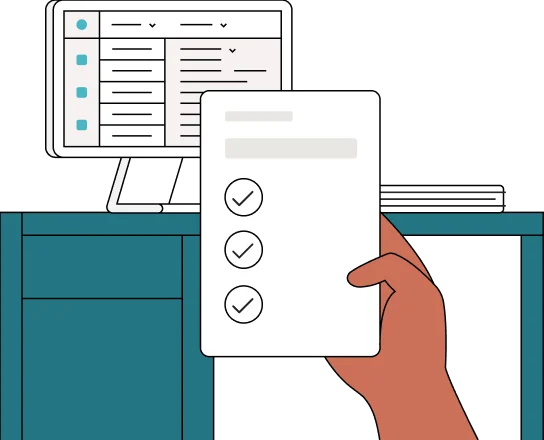How to form an LLC in Minnesota in 6 steps
Follow these steps to start your business and ensure you’re in good standing with the state.
1. Choose your business name
Before you start the business registration process, you need a name.
Your business name must be different enough to be distinguishable from other business names. In Minnesota, this means that it must have at least one letter or numeral different from another business. Acceptable differences include:
- Pluralization (Ex: Fine Wine Emporium vs. Fine Wines Emporium)
- Abbreviations (Ex: Mrs. Flo’s vs. Missus Flo’s)
- Misspellings (Ex: Quick Shop vs. Kwik Shop or Easy Peasy vs. EZ Peasy)
- Numerals or Roman numerals (Ex: Weed Killer 2 vs. Weed Killer II)
- Numerals or written out (Ex: These Three Bears vs. These 3 Bears)
- Entity designations (Ex: Roosevelt Inc. vs. Roosevelt LLC)
In addition to being different enough, your Minnesota business name should:
- Be in English
- Contain the words “limited liability company” or one of the following abbreviations: LLC, L.L.C., L. L. C.
- Not contain the word corporation
- Not imply that your business is organized for illegal activity
- Not include words implying association with a restricted or regulated industry, such as “bank” or “insurance,” unless those are business activities you are licensed to perform and you have proper authorization
Once you’ve chosen a business name that you like, you’ll perform a search on the Minnesota Secretary of State’s website to confirm that name is available to use.
If another business has already reserved that name or is using it, then you’ll need to pick a different name.
2. Appoint a registered office
In Minnesota, you must maintain a registered office. A registered office is a physical location (not a P.O. box) where a person representing the business can be found. A registered office functions similarly to a registered agent, which is required by most other states for LLCs.
The registered office can be the place where the business is located or somewhere else. It must be a full address, including a zip code.
In Minnesota, you may designate a registered agent in addition to your registered office, though it is not required. A registered agent must be a person who is a resident of Minnesota or a business authorized to transact business in Minnesota. The agent must be available during regular business hours to accept any official paperwork that might need to be mailed to you. If you aren't sure you could be available to receive official paperwork for your business, you can hire a registered agent service.
If your LLC moves or changes its registered agent, you must submit a change of address/agent form to the Minnesota Secretary of State.
3. File articles of organization
Your next step in starting your LLC Minnesota is to file your articles of organization. This document requires you to fill out your:
- Business name
- Registered office address
- Names and addresses of the organizers of the LLC
- Email address for official notices
- Phone number for questions about the form
The Articles of Information form can be filed online, in person, or by mail. When filing, you’ll be required to pay a filing fee. The fee differs based on how you submit the form.
- By mail: $135
- Online and in-person filing: $155
What if… there was an easier way to start your LLC?
LegalZoom helps you handle every step—from choosing a business name to filing paperwork with your state.

4. Create an operating agreement
Once you’ve registered your Minnesota limited liability company, it’s time to think about how you’re going to build and operate the business.
An LLC operating agreement is not required by Minnesota law, but it can help you outline the ownership structure, each person’s roles, and how you want the business to operate.
5. Obtain an EIN and open a business bank account
Your next step is to get an EIN for your business. An employer identification number (EIN) is like a social security number for your business. Your EIN will be used to file your federal tax returns for your business. You will also use your EIN to open a business bank account and hire employees.
You can apply for an EIN for free through the Internal Revenue Service (IRS) website.
6. Register for state taxes and business licenses
In addition to your EIN from the IRS, you also need a Minnesota Tax ID Number. You can apply for this through the Minnesota Department of Revenue. You’ll use this number to pay your state taxes and apply for any required business licenses.
Minnesota department
Minnesota doesn’t require a state business license for all businesses. You might need a business license depending on your industry or what products you sell. You can search the Minnesota business license page to find out if your specific business requires a license.
Your business is precious—start protecting it with a trademark.
You've worked hard to build a brand. Help keep it safe with a federal trademark from America’s #1 trademark filer.

What to do after forming your Minnesota LLC
Once you’ve completed all the steps, formed your Minnesota LLC, and filed the proper forms so your business is fully compliant, then it’s time to start operating your business.
To do that, you’ll need to get an online presence so you can do some marketing, stay in compliance with the state, and consider expanding your business.
Register a domain name
For the vast majority of small businesses, one of the easiest ways for customers to learn about them or find information is to have an online presence. That means building a website.
Before you even think about building a website, you need a domain name. Your business URL should represent your business name and be easy to remember and search so that customers can find you.
Maintain compliance
To stay compliant in Minnesota, you’re required to file a free annual report. The annual renewal form must be filed by December 31 each year to remain in good standing with the state of Minnesota.
The form asks for:
- Business name
- Registered office address
- Contact information for business owner
Obtain a certificate of good standing
If you are taking out a loan or applying for a payment processing system, you may be asked for a certificate of good standing.
You can apply for a certificate of good standing through the Minnesota Secretary of State. You will pay $15 online to get your certificate, or $5 by mail or in person. Though not always required, it can be helpful to have a certificate of good standing while setting up your business.
Consider a foreign LLC
If you’re interested in expanding your business into other states, you will also need to register as a foreign LLC in those states. Registering a business in another state requires filing a document such as a certificate of registration or qualification.
Each state has its own process for registering as a foreign LLC. You can find out about that state’s process online by looking at their Secretary of State’s website. You will likely need your certificate of good standing during this registration process.
You focus on growth. We’ll handle your LLC formation.

The cost of forming an LLC in Minnesota
When forming your LLC, there are a few fees you can expect to pay. These include:
- LLC filing fee: $135 by mail, $155 in person or online
- Change of registered office or agent: $35 by mail, $55 in person or online
- Certificate of good standing: $5 by mail or in person, $15 online
In addition to these costs, you may also need to pay for any applicable state or federal business licenses. While not required, you may want help throughout this process. You can hire a service to register your LLC for you or purchase templates for your operating agreement.
Special considerations for Minnesota LLCs
When registering your business in Minnesota, there are a few critical things to keep in mind.
- Minnesota requires you to file an annual renewal. This report is free to file, but if it’s not filed, your business will no longer be in good standing with the state. This can result in fines.
- Unlike most other states, Minnesota requires a registered office. This means, you’ll need to have an address registered with the state where you can receive official mail. The address cannot be a P.O. box.
Each of the 50 states has slightly different rules and regulations for businesses within their state. It’s important to follow state-specific guidelines when registering your LLC.
How to start your Minnesota LLC with LegalZoom
Starting a business means you have an endless to do list. The process can be overwhelming. If you’ve already got one too many things on your list and are feeling stressed, let us take something off. LegalZoom can register your LLC for you with just a few simple steps. All you have to do is fill out a quick questionnaire and let us handle the rest.
Your business is precious—start protecting it with a trademark.
You've worked hard to build a brand. Help keep it safe with a federal trademark from America’s #1 trademark filer.

Start an LLC in Any State
FAQs
What are the benefits of filing an LLC in Minnesota?
An LLC or limited liability company provides business owners with protection against personal liability. An LLC creates a divide between you as an individual person and the business. If someone were to file a lawsuit against the business, your personal assets would not be included in that lawsuit.
What are the annual filing requirements for Minnesota?
In Minnesota, you must file an annual report. Filing this report is free and simple. You can fill it out electronically and file online. The report asks for basic information about your business entity, such as the name, owner’s contact information, and the address for your registered office.
How do I correct filing errors in MN?
If you’ve made an error and want to amend your articles of organization, you’ll fill out and file an amendment form. Filing this form costs $35 by mail and $55 in person or online.
If you need to update your registered office address because you’ve moved, you’ll fill out and file a notice of change form. Filing this form costs $35 by mail and $55 in person or online filings.
How do I dissolve a Minnesota LLC?
To dissolve an LLC in Minnesota, you’ll file a statement of dissolution. Once the form has been filled out, you’ll file it with the Secretary of State and pay the filing fee. The cost is $35 by mail or $55 in person or online.
Rudri Bhatt Patel contributed to this article.


